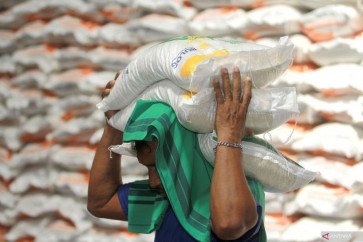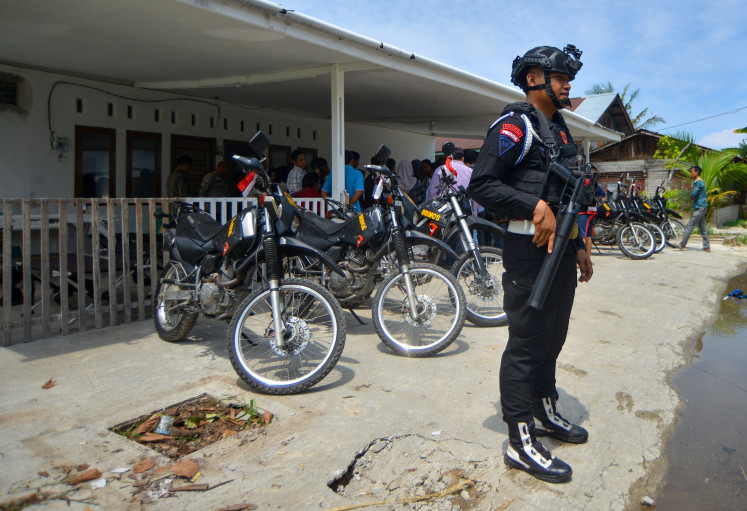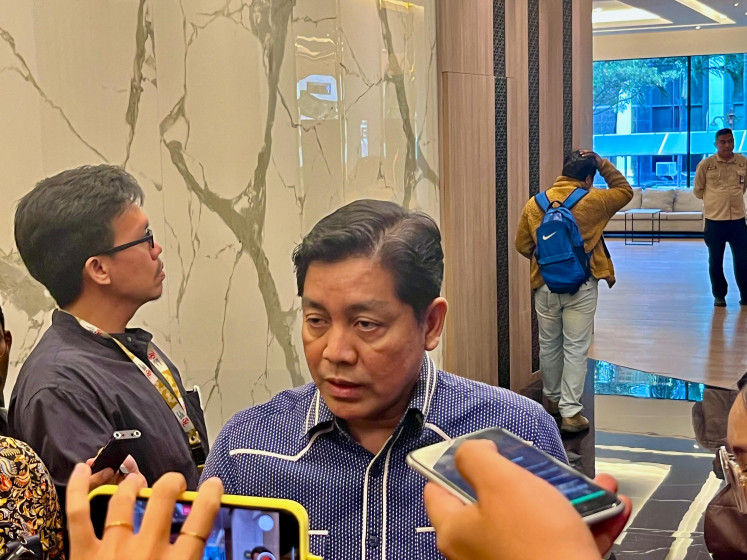Popular Reads
Top Results
Can't find what you're looking for?
View all search resultsPopular Reads
Top Results
Can't find what you're looking for?
View all search resultsBusiness players, govt at odds on RI-Japan partnership
When the Indonesia-Japan Economic Partnership Agreement (IJ-EPA) came into force on July 1, 2008, both governments expressed their optimism that the accord could serve as a model for solid bilateral economic cooperation due to the complementary character of the two economies
Change text size
Gift Premium Articles
to Anyone
W
hen the Indonesia-Japan Economic Partnership Agreement (IJ-EPA) came into force on July 1, 2008, both governments expressed their optimism that the accord could serve as a model for solid bilateral economic cooperation due to the complementary character of the two economies.
The agreement, signed by President Susilo Bambang Yudhoyono and Japanese prime minister Shinzo Abe on Aug. 20, 2007, promises opportunities beyond trade liberalization as it offers cooperation in which Japan is committed to provide substantial resources for capacity-building activities to Indonesia, including in the areas of manufacturing industries and services.
More than three years have passed, and questions linger as to whether Indonesia’s first bilateral trade agreement really runs the right course.
During the 2008-2011 period, the world economy struggled for growth following the financial meltdown in the US and the emergence of the sovereign debt crisis in the European Union.
Spillover from the economic turbulence was also reflected in the figures of bilateral trade between Indonesia and Japan. Once Indonesia’s top export destination and largest source of imports, and investment, Japan has since slipped to second place behind Singapore.
The combined trade value between the two countries plunged to US$28.42 billion in 2009, a 33.7 percent drop from $42.87 billion a year earlier. Trade figures improved in 2010 with a total value of $42.75 billion. By the end of 2011, bilateral trade was valued at $48.44 billion, up 25.66 percent from a year earlier, according to data at the Trade Ministry.
Realized investment by Japanese firms in Indonesia also rose and declined according to the country’s economic curves. In 2008, realized direct investment of Japanese firms stood at $1.27 billion, followed by a two-year drop: $684.9 million in 2009 and $712.6 million in 2010. Last year, Indonesia saw $1.5 billion of direct investment from Japan, making it Indonesia’s second largest investor after Singapore.
Indonesia Textile Association chairman Ade Sudrajat said that Japan was now Indonesia’s top textile export destination as textile exports to the country climbed significantly after the accord took effect a few years ago.
“Our Japanese partner helps us open market access, by introducing our textile businessmen to Japan fashion events,” he said, adding that cooperation in the textile industry also went well with Japan textile stakeholders facilitating three-month dyeing trainings for local textile makers in West and Central Java every year since 2009.
However, Ade expected that Japanese firms, widely known for their advanced technology, would invest in the textile machinery sector to further support the local textile industry.
Indonesian Automotive Industry Association (Gaikindo) deputy chairman Jongkie D. Sugiarto said that investment had grown quickly in the automotive industry, particularly in recent years, as Japanese automakers enlarged their production capacities of their Indonesian facilities. This was partly attributed to lower tariffs imposed on the components coming from Japan.
“The transfer of technology has also occurred, as seen in the higher local content of automobiles, more than 80 percent at present,” he said. Certain car models, Jongkie went on, were also designed in Indonesia, whether to fulfill local demand or overseas orders.
According to Jongkie, the EPA has included many positive aspects that could be applied in similar agreements with other countries in the future and serve as a model for a win-win cooperative deal.
Despite the gains perceived by certain industrial sectors, dissenting views on the implementation of the agreement have been shared by policymakers and observers.
While acknowledging that the EPA could become a model for other future bilateral agreement at the conceptual level, Industry Minister MS Hidayat recently expressed his disappointment as Indonesia’s imports of industrial products from Japan were lower than its exports.
According to the ministry’s data, Indonesian imports of industrial goods rose by 37.7 percent to $16.84 billion in 2010, while exports only increased by 1.2 percent to $10.02 billion. In the past year, Indonesian exports of manufactured goods to Japan were valued at $12.34 billion, while imports totaled $23.60 billion.
“The capacity-building program we agreed upon that intended to boost the skills and competency of our engineers does not run well and must be improved. We will request this again in our next official meeting,” he said.
The Industry Ministry’s international industry cooperation director general Agus Tjahajana raised a similar concern, saying that improvement would be necessary in the capacity-building aspects to allow Indonesia a more balanced edge.
“The capacity-building activities have been conducted, but have yet to fulfill our expectations. We should work to improve it,” he said, in reference to previously held trainings, seminars and workshops, research and expert visits.
Under the EPA’s initiative for Manufacturing Industry Development Center (MIDEC), Japan has committed to help enhance the competitiveness of Indonesia’s manufacturing industry in wide array of sectors, including metalworking, tooling techniques, welding techniques, automotive production, textiles, petrochemicals, oleochemicals, and energy conservation.
Haposan Saragih, the director of government placement of the National Agency for the Placement and Protection of Indonesian Migrant Workers (BNP2TKI), said that the Japanese government had done well in facilitating the movement of Indonesian nurses and caregivers, as designated by the EPA, by providing trainings at home as well as in Japan.
“However, it seems there has been no clear framework for the training. The period of training changes every year. At the implementation level, they are not committed to the requested figure of workers, and some previously agreed upon deals were dropped in the end,” he said.
As of end of last year, Indonesia had sent 791 nurses and caregivers to Japan under the agreement’s framework.
Yoshinari Yajima, the chairman of Taiju Research Institute, a nonpartisan policy research organization with a strong network of connections to the Japanese government, said during a recent visit that the framework needed some changes to allow both parties to gain mutual benefits.
“We feel that Indonesia is not satisfied with the IJ-EPA. After a few years of implementation, we think the framework should be changed to be beneficial for both countries, instead of Japan only,” he said, adding that changes might include the recruitment and management of nurses and caregivers from Indonesia.
Yajima said his institute had proposed a recommendation to Japan’s cabinet ministers to establish a framework that would yield additional benefits for Indonesia.
“They have understood our suggestions. In the near future, there will be clear changes in that regard,” he said.
Latif Adam, an economist at the Indonesian Institute of Sciences (LIPI), said that despite improvements expected from Japan, Indonesia had to consider enhancing domestic competitiveness since neighboring countries, such as Malaysia and Thailand, have also carried out similar cooperation agreements with Japan.
“There’s an indication that the transfer of technology from Japanese firms is still less than expected, and this is, among others, due to lack of incentives offered by our government. If they offer technology transfers to local firms, the government must provide various facilities, including fiscal incentives,” he said.

 Q
Q










